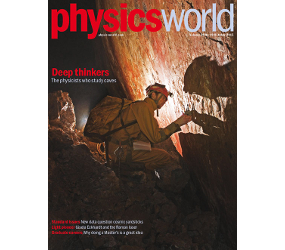A handful of scientists are combining their favourite hobby with their day job, to form the emerging field of “speleophysics” – exploring how underground caves form, evolve and move water from one place to another.
Writing in October the 2015 issue of Physics World magazine Stephen Ornes describes how a small group of physicists from around the world are trying to merge physics, chemistry and mathematics to unlock the secrets of caves.
One area of interest is the formation, evolution and movement of ‘karst’ – a general term for the landforms that have been sculpted by dissolution or soluble rocks such as limestone.
“There are still so many open questions in speleogenesis (cave formation)” explains Franci Gabrovšek, a physicist at the Karst Research Institute in Postojna, Slovenia. “Caves are the last parts of Earth which are not yet explored … they are so full of surprises, and when you progress to the next step, you never know what your next challenge will be.”
The route to pursuing ‘speleophysics’ is a circuitous one for these researchers. In the article, Gabrovšek describes the challenges of finding collaborators at the dawn of the internet age.
Another ‘speleophysicist’, Matt Covington, based at the University of Arkansas, explains how a lecture discussing theories on mapping galaxy formation led him to wonder if physics equations could be applied to caves, and subsequently to join forces with Gabrovšek.
Mapping and studying caves differs noticeably from exploration, explains Covington. “You experience the cave at a slow pace and absorb a lot of information about the cave that you wouldn’t necessarily observe if you were just going through.”
There’s also a practical concern at stake in speleophysics – roughly 20% of the fresh water supply in the US, and about 10% in Europe – comes from karst aquifers. This water can move quickly through the labyrinthine network of channels within a cave and its movement can be dramatically effected by flooding or seasonal changes.
“You put a pollutant in somewhere, and you don’t know where that pollutant with come out” adds Gabrovšek.
Not surprisingly, most of the researchers began caving as a hobby, before realising this ideal way to combine it with their profession.
Also in this month’s Physics World:
- Standard issues – how new cosmological data are questioniong the use of supernovae as cosmic yardsticks
- Laser pioneer – the life and times of Gisela Eckhardt, who discovered the Raman laser
The new issue of Physics World can be read in our digital edition from 1 October at http://live.iop-pp01.agh.sleek.net/physicsworld/reader or via the Physics World app. Membership of the Institute of Physics is required for access to articles.
This article will also be freely available from 1 October at http://live.iop-pp01.agh.sleek.net/physicsworld/reader/#!edition/editions_neutron-2015/article/page-9672
